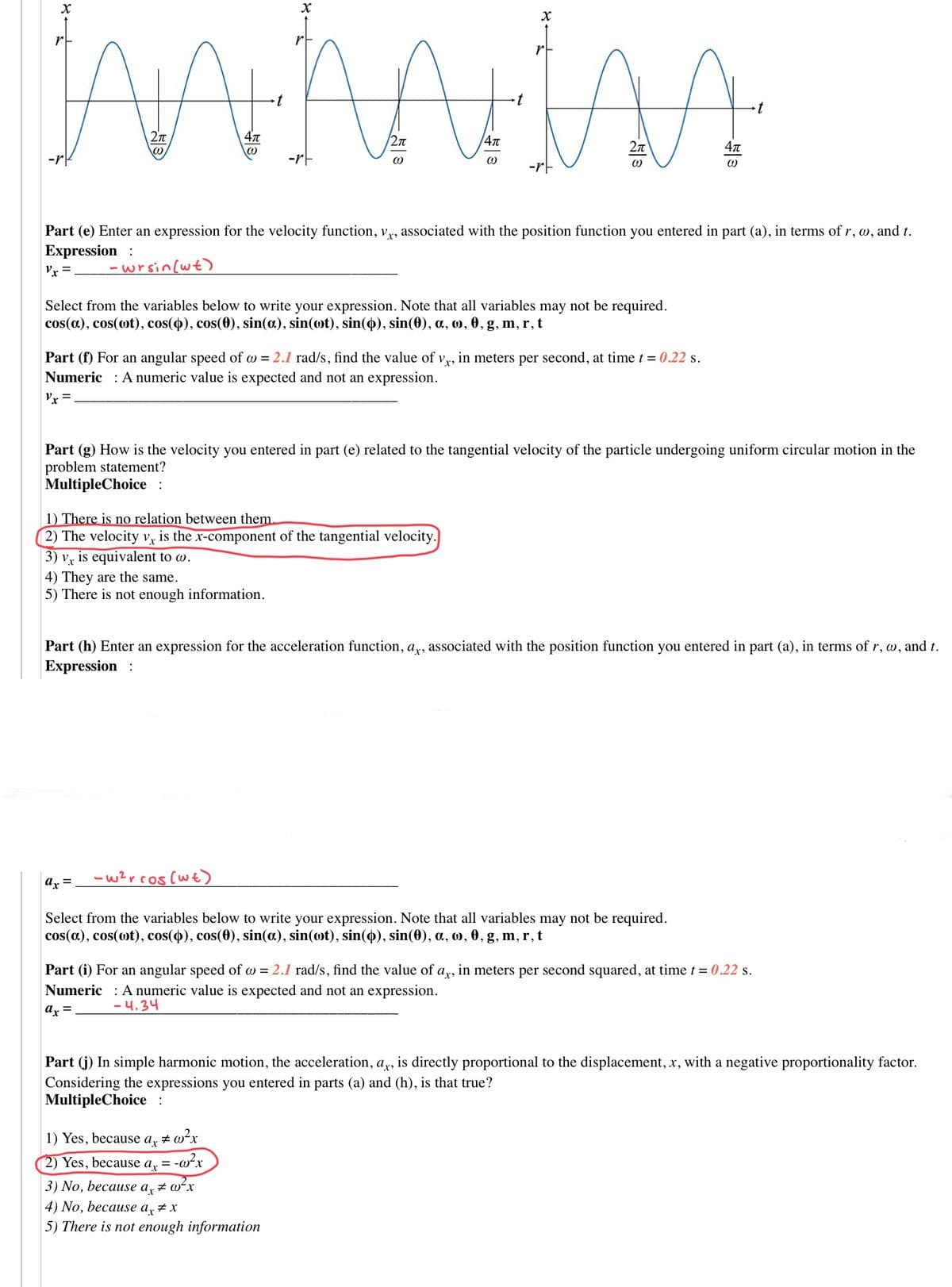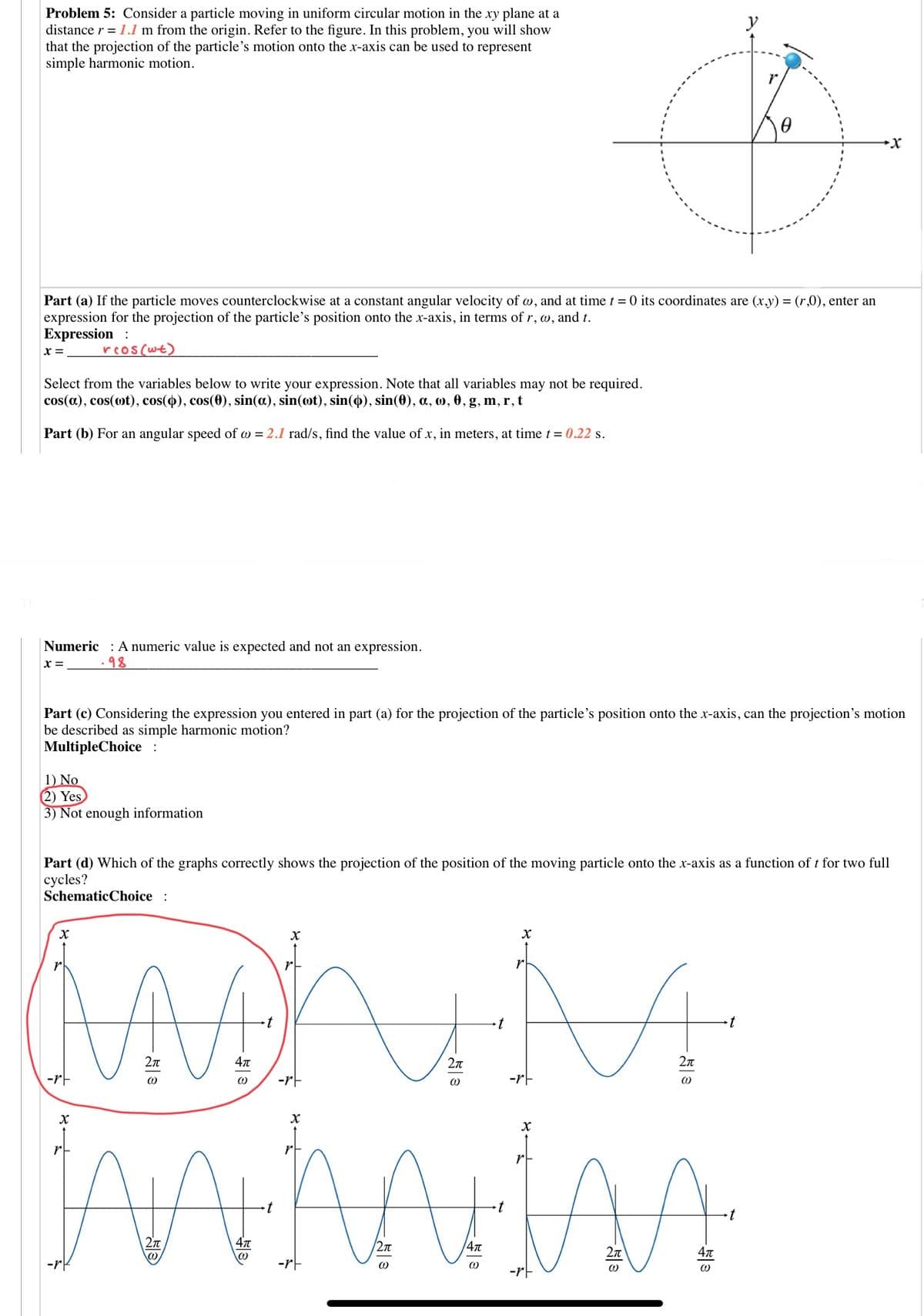Classical Dynamics of Particles and Systems
5th Edition
ISBN:9780534408961
Author:Stephen T. Thornton, Jerry B. Marion
Publisher:Stephen T. Thornton, Jerry B. Marion
Chapter2: Newtonian Mechanics-single Particle
Section: Chapter Questions
Problem 2.52P: A particle of mass m moving in one dimension has potential energy U(x) = U0[2(x/a)2 (x/a)4], where...
Related questions
Question
10.5 please answer part f, other parts are answered

Transcribed Image Text:/2n
-rk
-rF
-rt
Part (e) Enter an expression for the velocity function, v,, associated with the position function you entered in part (a), in terms of r, w, and t.
Expression :
Vx =.
-wrsin[wt)
Select from the variables below to write your expression. Note that all variables may not be required.
cos(a), cos(ot), cos(4), cos(0), sin(a), sin(ot), sin(4), sin(0), a, o, 0, g, m, r, t
Part (f) For an angular speed of w = 2.1 rad/s, find the value of vy, in meters per second, at time t = 0.22 s.
Numeric : A numeric value is expected and not an expression.
Vx =
Part (g) How is the velocity you entered in part (e) related to the tangential velocity of the particle undergoing uniform circular motion in the
problem statement?
MultipleChoice :
1) There is no relation between them.
2) The velocity Vỵ is the x-component of the tangential velocity.
3) vỵ is equivalent to w.
4) They are the same.
5) There is not enough information.
Part (h) Enter an expression for the acceleration function, a,x, associated with the position function you entered in part (a), in terms of r, w, and t.
Expression :
-w2rcos(wt)
ar =
Select from the variables below to write your expression. Note that all variables may not be required.
cos(a), cos(ot), cos(4), cos(0), sin(a), sin(ot), sin(4), sin(0), a, o, 0, g, m, r, t
Part (i) For an angular speed of w = 2.1 rad/s, find the value of a,, in meters per second squared, at time t = 0.22 s.
Numeric : A numeric value is expected and not an expression.
-4.34
ax =
Part (j) In simple harmonic motion, the acceleration, ay, is directly proportional to the displacement, x, with a negative proportionality factor.
Considering the expressions you entered in parts (a) and (h), is that true?
MultipleChoice :
1) Yes, because
ax
2) Yes, because
-w?x
ax
3) No, because a, # wʻx
4) No, because a, # x
5) There is not enough information

Transcribed Image Text:Problem 5: Consider a particle moving in uniform circular motion in the xy plane at a
distance r = 1.1 m from the origin. Refer to the figure. In this problem, you will show
that the projection of the particle's motion onto the x-axis can be used to represent
simple harmonic motion.
y
r.
Part (a) If the particle moves counterclockwise at a constant angular velocity of w, and at time t = 0 its coordinates are (x,y) = (r,0), enter an
expression for the projection of the particle's position onto the x-axis, in terms of r, w, and t.
Expression :
x =
reos(wt)
Select from the variables below to write your expression. Note that all variables may not be required.
cos(a), cos(ot), cos(), cos(0), sin(a), sin(ot), sin(o), sin(0), a, o, 0, g, m, r, t
Part (b) For an angular speed of w = 2.1 rad/s, find the value of x, in meters, at time t = 0.22 s.
Numeric : A numeric value is expected and not an expression.
x =
.98
Part (c) Considering the expression you entered in part (a) for the projection of the particle's position onto the x-axis, can the projection's motion
be described as simple harmonic motion?
MultipleChoice :
1) No
2) Yes
3) Not enough information
Part (d) Which of the graphs correctly shows the projection of the position of the moving particle onto the x-axis as a function of t for two full
cycles?
SchematicChoice :
MAY
r
2n
2n
2л
-rt
-rF
-rF
t
/2n
-rF
-rE
Expert Solution
This question has been solved!
Explore an expertly crafted, step-by-step solution for a thorough understanding of key concepts.
This is a popular solution!
Trending now
This is a popular solution!
Step by step
Solved in 2 steps

Knowledge Booster
Learn more about
Need a deep-dive on the concept behind this application? Look no further. Learn more about this topic, physics and related others by exploring similar questions and additional content below.Recommended textbooks for you

Classical Dynamics of Particles and Systems
Physics
ISBN:
9780534408961
Author:
Stephen T. Thornton, Jerry B. Marion
Publisher:
Cengage Learning

Physics for Scientists and Engineers: Foundations…
Physics
ISBN:
9781133939146
Author:
Katz, Debora M.
Publisher:
Cengage Learning

Principles of Physics: A Calculus-Based Text
Physics
ISBN:
9781133104261
Author:
Raymond A. Serway, John W. Jewett
Publisher:
Cengage Learning

Classical Dynamics of Particles and Systems
Physics
ISBN:
9780534408961
Author:
Stephen T. Thornton, Jerry B. Marion
Publisher:
Cengage Learning

Physics for Scientists and Engineers: Foundations…
Physics
ISBN:
9781133939146
Author:
Katz, Debora M.
Publisher:
Cengage Learning

Principles of Physics: A Calculus-Based Text
Physics
ISBN:
9781133104261
Author:
Raymond A. Serway, John W. Jewett
Publisher:
Cengage Learning